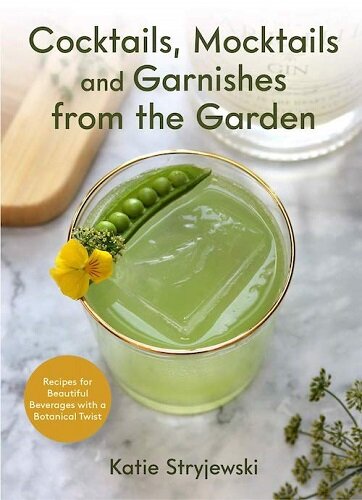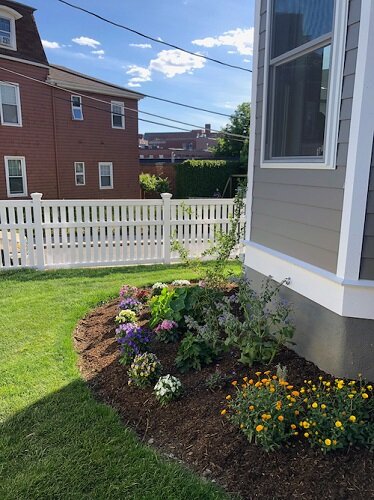Meet Dr. Katie Stryjewski: Author, Blogger and Garnishista
Cocktails, Mocktails and Garnishes form the Garden
An evolutionary biologist walks into a bar.
So begins the origin story of a distinctive new addition to the mixology canon; a smart little book with a ridiculously long title: Cocktails, Mocktails, and Garnishes from the Garden: Recipes for Beautiful Beverages with a Botanical Twist. In 2008, author/photographer Katie Stryjewski moved from Louisiana to Massachusetts to pursue her doctorate, studying molecular genetics at Boston University (She later did post-doc work at Harvard). By night, seeking a break from the rigors of academia, Stryjewski and her husband, a medical student, found themselves drawn to the stylish improvisations of the city’s emerging craft cocktail scene.
Intrigued by the adventurous pleasures of contemporary mixology but living on a student budget, Stryjewski began to build a home bar and develop drinks of her own. A longtime gardener, she used fresh homegrown garnishes to create cocktails that were visually and flavorfully distinctive, all the while refining her skills at cultivating plants, growing from cuttings, choosing the right seeds and soils, and other green thumb skills she shares in her book.
By 2015, her pastime had become a passion and Stryjewski launched Garnish, a blog which eventually built a following of over 20,000 monthly readers and caught the attention of her publisher. Alcohol Professor recently chatted with her about how fancy cocktails led her down the garden path to a book she never expected to write.
How do you see your academic background overlapping with your interest in cocktails?
Katie Stryjewski (KS):Early on, I didn’t think there really was much of a connection. Going to craft bars with my husband was really a release from studying and working in the lab. And making drinks at home was a way to get back in touch with my creativity, which was probably feeling a bit stifled—I’ve always loved cooking but hadn’t been doing enough of it. But as time has passed, I’ve started to see more commonalities.
Katie Stryjewski
In academia, I always enjoyed research and history, so when I began delving into cocktails, it really turned me on that I could make the exact same drinks that people were mixing 100 or 200 years ago. And I like that you can put together a collection of bottles that are the elements for building an infinite number of different drinks.
I’m also into ornithology and birding and tracking down unusual bottles for our home bar also reminds me a bit of that birder’s impulse.
Are you still involved in scholarly work?
KS: I’m not working in the lab anymore. There are a few papers I’ve contributed to that may still find their way to publication. But I’m spending most of my time now with our toddler and working on the blog and my Instagram account, which have become almost a full-time job. Developing drinks, writing, shooting photographs, and managing sponsorships, and the website takes about three full days a week, which I do when our son is in daycare.
There are so many cocktail books on the market. What do you think makes yours stand out?
KS: Oh, it’s definitely the gardening aspect. The cocktail recipes I include are fairly basic—I wanted a beginner to be able to use the book without buying a lot of weird liqueurs. But pretty much every garnish I feature in the recipes is something I’ve grown myself and explain how to grow in the gardening section of the book. The only thing I haven’t grown is the citrus, but in March, I moved from an apartment into a real house, so now I can plant some of my own citrus trees.
Can you actually create a decent garnish garden if you live in an apartment?
KS: You don’t need a lot of space at all. I grew a lot in containers on my balcony. I give lots of advice on planting and growing in the book.
What are some of the garnish ingredients you recommend tipsy would-be gardeners get started with?
KS: Mint is absolutely #1. It grows like crazy in pots or garden beds. And it’s used in so many cocktails, either as a garnish or actually muddled into the drink. It definitely gives you the most bang for the buck, and it just feels really good to use an ingredient you’ve grown yourself. In terms of edible flowers, the violas—which include pansies and the smaller Johnny Jump-Ups are definitely go-tos. I also recommend dianthus flowers, which are pink and white. And if you can grow it, citrus, of course: There are very few garnishes that have as much impact on the flavor and aroma of a drink than a well-executed citrus twist. Too many home bartenders don’t understand that “twist” isn’t meant to describe the piece of peel you might leave in the drink, its the action of properly expressing the peel’s oils—If you ever make cocktails, you need to learn to do it correctly.
Flowers like pansies don’t really add much flavor do they?
KS: I use garnishes to add flavor, aroma, and visual appeal—and every garnish doesn’t need to do all three. We drink with our eyes first and making a drink look great—whether with a garnish or with glassware—is part of the creativity of it. How many times have you sat in a bar and heard people with an impressive looking cocktail being asked what they ordered. I’ve been doing my blog for five years, but it wasn’t until I started posting a lot of pictures on Instagram @garnishgirl that it really blew up. The photos were driving people to check out the writing. So I am all in with making drinks look great. That said, its critical to be sure that any leaves or herbs, or flowers you use on a cocktail are edible, even if you’re not primarily using them for looks. There’s always someone who’s going to chomp down on the flower.
Are there any flowers you recommend for flavor or fragrance as well as visual appeal?
KS: I really like to use the flowers of herbs. Plants like thyme and rosemary are easy to grow, and the flowers smell and taste like the more familiar parts of the plants. Instead of putting a sprig in a drink that calls for rosemary, the flowers can make it prettier. Borage is a great plant to grow: both the leaves and the flowers have a nice cucumber flavor. And nasturtium blossoms add great color and a bit of spiciness to a cocktail.
How do you feel about plastic monkeys, swords and other novelty garnishes?
KS: I don’t think there’s anything wrong with having fun, so most everything is ok by me as long as it doesn’t appear to be edible but isn’t. I know people who are opposed to using miniature clothespins to clip herbs to the inside of a coupe, but I think it can look cool—and it gives you the flavor without having the leaves swimming around on the surface of your drink. Actually, the one pet peeve I have about garnishes right now is the trend of printing images on edible rice paper and floating them. Yes, the paper and ink are harmless to eat, but if a bartender uses more than a little swatch, you wind up with a soggy wad in your mouth at some point, which really impedes on the overall pleasure of a good cocktail.
One last flower question. But it’s not about a garnish. In your section on putting together a first home bar, you recommend 14 fairly mainstream bottles: rum, gin, vodka, tequila, whiskey, Campari, Angostura bitters and other traditional staples. So how did elderflower liqueur—which only came to market in 2007—make your cut?
KS: Well, elderflower works in everything. It’s a very appealing flavor to incorporate in a daquiri, a gimlet and lots of other drinks. And it feels like something really special when you have it on your bar, something that raises the level of the basics. I almost decided to leave it off of my final list, but my publisher really wanted me to include it. You’d be surprised how popular and versatile it is.




